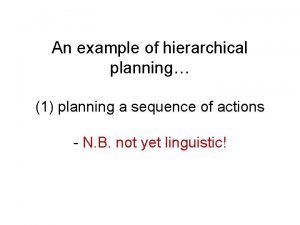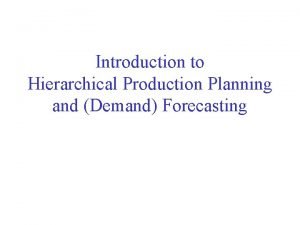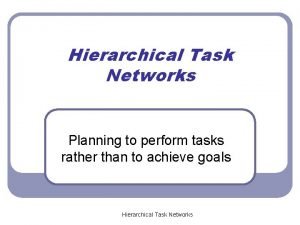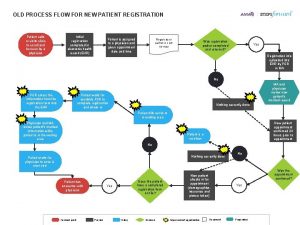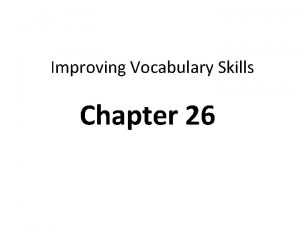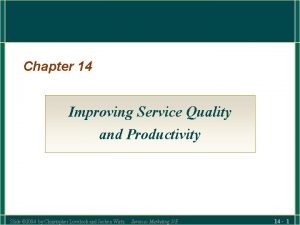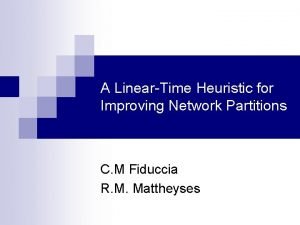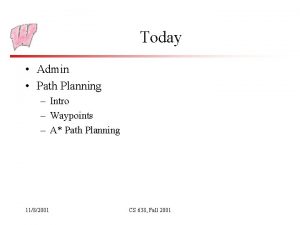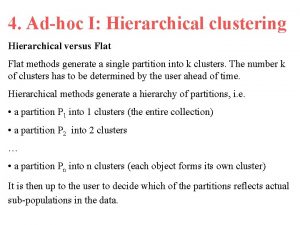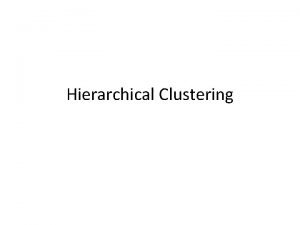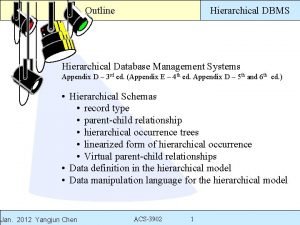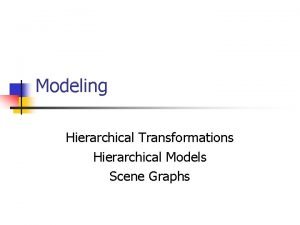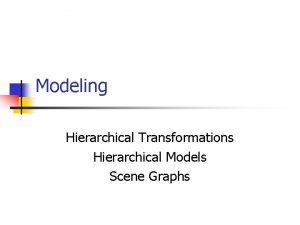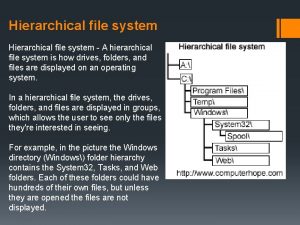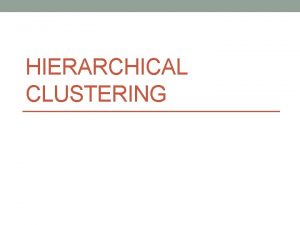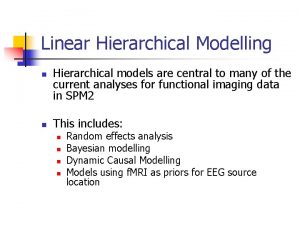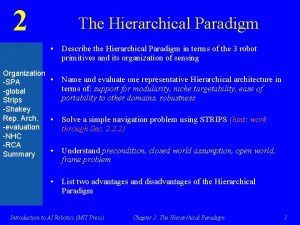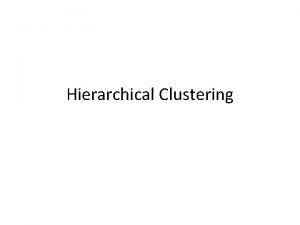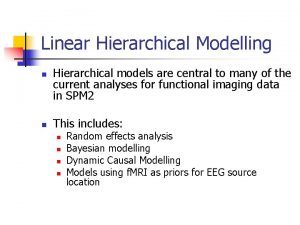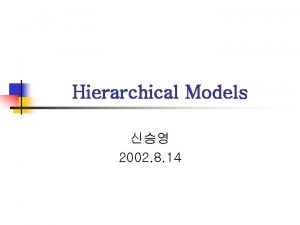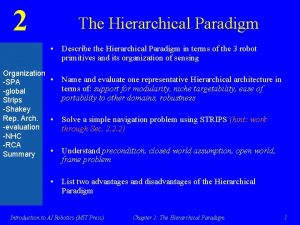Today Path Planning Improving A Hierarchical Path Planning























- Slides: 23

Today • Path Planning – Improving A* – Hierarchical Path Planning – Pre-planning 11/20/2001 CS 638, Fall 2001

A* Problems • Discrete Search: – Must have simple paths to connect waypoints • Typically use straight segments • Have to be able to compute cost • Must know that the object will not hit obstacles – Leads to jagged, unnatural paths • Infinitely sharp corners • Jagged paths across grids • Efficiency is not great – Finding paths in complex environments can be very expensive 11/20/2001 CS 638, Fall 2001

Path Straightening • Straight paths typically look more plausible than jagged paths, particularly through open spaces • Option 1: After the path is generated, from each waypoint look ahead to farthest unobstructed waypoint on the path – Removes many segments and replaces with one straight one – Could be achieved with more connections in the waypoint graph, but that would increase cost • Option 2: Bias the search toward straight paths – Increase the cost for a segment if using it requires turning a corner – Reduces efficiency, because straight but unsuccessful paths will be explored preferentially 11/20/2001 CS 638, Fall 2001

Smoothing While Following • Rather than smooth out the path, smooth out the agent’s motion along it • Typically, the agent’s position linearly interpolates between the waypoints: p=(1 -u)pi+upi+1 – u is a parameter that varies according to time and the agent’s speed • Two primary choices to smooth the motion – Change the interpolation scheme – “Chase the point” technique 11/20/2001 CS 638, Fall 2001

Different Interpolation Schemes • View the task as moving a point (the agent) along a curve fitted through the waypoints • We can now apply classic interpolation techniques to smooth the path: splines • Interpolating splines: – The curve passes through every waypoint, but may have nasty bends and oscillations • Hermite splines: – Also pass through the points, and you get to specify the direction as you go through the point • Bezier or B-splines: – May not pass through the points, only approximate them 11/20/2001 CS 638, Fall 2001

Interpolation Schemes Interpolating 11/20/2001 Hermite CS 638, Fall 2001 B-Spline

Chase the Point • Instead of tracking along the path, the agent chases a target point that is moving along the path • Start with the target on the path ahead of the agent • At each step: – Move the target along the path using linear interpolation – Move the agent toward the point location, keeping it a constant distance away or moving the agent at the same speed • Works best for driving or flying games 11/20/2001 CS 638, Fall 2001

Chase the Point Demo 11/20/2001 CS 638, Fall 2001

Still not great… • The techniques we have looked at are path post-processing: they take the output of A* and process it to improve it • What are some of the bad implications of this? – There at least two, one much worse than the other – Why do people still use these smoothing techniques? • If post-processing causes these problems, we can move the solution strategy into A* 11/20/2001 CS 638, Fall 2001

A* for Smooth Paths http: //www. gamasutra. com/features/20010314/pinter_01. htm • You can argue that smoothing is an attempt to avoid infinitely sharp turns • Incorporating turn radius information can fix this • Option 1: Restrict turn radius as a post-process – But has all the same problems as other post processes • Option 2: Incorporate direction and turn radius into A* itself – Add information about the direction of travel when passing through a waypoint – Do this by duplicating each waypoint 8 times (for eight directions) – Then do A* on the expanded graph – Cost of a path comes from computing bi-tangents … 11/20/2001 CS 638, Fall 2001

Using Turning Radius Fixed start direction, any finish direction: 2 options Fixed direction at both ends: 4 options Curved paths are used to compute cost, and also to determine whether the path is valid (avoids obstacles) 11/20/2001 CS 638, Fall 2001

Improving A* Efficiency • Recall, A* is the most efficient optimal algorithm for a given heuristic • Improving efficiency, therefore, means relaxing optimality • Basic strategy: Use more information about the environment – Inadmissible heuristics use intuitions about which paths are likely to be better • E. g. Bias toward getting close to the goal, ahead of exploring early unpromising paths – Hierarchical planners use information about how the path must be constructed • E. g. To move from room to room, just must go through the doors 11/20/2001 CS 638, Fall 2001

Inadmissible Heuristics • A* will still gives an answer with inadmissible heuristics – But it won’t be optimal: May not explore a node on the optimal path because its estimated cost is too high – Optimal A* will eventually explore any such node before it reaches the goal • However, inadmissible heuristics may be much faster – Trade-off computational efficiency for path-efficiency – Start ignoring “unpromising” paths earlier in the search – But not always faster – initially promising paths may be dead ends • Recall additional heuristic restriction: estimates for path costs must increase along any path from the start node 11/20/2001 CS 638, Fall 2001

Inadmissible Example • Multiply an admissible heuristic by a constant factor (See Gems for an example of this) • Why does this work? – The frontier in A* consists of nodes that have roughly equal estimated total cost: f = cost_so_far + estimated_to_go – Consider two nodes on the frontier: one with f=1+5, another with f=5+1 – Originally, A* would have expanded these at about the same time – If we multiply the estimate by 2, we get: f=1+10 and f=5+2 – So now, A* will expand the node that is closer to the goal long before the one that is further from the goal 11/20/2001 CS 638, Fall 2001

Hierarchical Planning • Many planning problems can be thought of hierarchically – To pass this class, I have to pass the exams and do the projects – To pass the exams, I need to go to class, review the material, and show up at the exam – To go to class, I need to go to 1221 at 2: 30 Tu. Th • Path planning is no exception: – To go from my current location to slay the dragon, I first need to know which rooms I will pass through – Then I need to know how to pass through each room, around the furniture, and so on 11/20/2001 CS 638, Fall 2001

Doing Hierarchical Planning • Define a waypoint graph for the top of the hierarchy – For instance, a graph with waypoints in doorways (the centers) – Nodes linked if there exists a clear path between them (not necessarily straight) • For each edge in that graph, define another waypoint graph – This will tell you how to get between each doorway in a single room – Nodes from top level should be in this graph • First plan on the top level - result is a list of rooms to traverse • Then, for each room on the list, plan a path across it – Can delay low level planning until required - smoothes out frame time 11/20/2001 CS 638, Fall 2001

Hierarchical Planning Example Plan this first 11/20/2001 Then plan each room (second room shown) CS 638, Fall 2001

Hierarchical Planning Advantages • The search is typically cheaper – The initial search restricts the number of nodes considered in the latter searches • It is well suited to partial planning – Only plan each piece of path when it is actually required – Averages out cost of path over time, helping to avoid long lag when the movement command is issued – Makes the path more adaptable to dynamic changes in the environment 11/20/2001 CS 638, Fall 2001

Hierarchical Planning Issues • Result is not optimal – No information about actual cost of low level is used at top level • Top level plan locks in nodes that may be poor choices – Have to restrict the number of nodes at the top level for efficiency – So cannot include all the options that would be available to a full planner • Solution is to allow lower levels to override higher level – Textbook example: Plan 2 lower level stages at a time • E. g. Plan from current doorway, through next doorway, to one after • When reach the next doorway, drop the second half of the path and start again 11/20/2001 CS 638, Fall 2001

Pre-Planning • If the set of waypoints is fixed, and the obstacles don’t move, then the shortest path between any two never changes • If it doesn’t change, compute it ahead of time • This can be done with all-pairs shortest paths algorithms – Dijkstra’s algorithm run for each start point, or special purpose allpairs algorithms • The question is, how do we store the paths? 11/20/2001 CS 638, Fall 2001

Storing All-Pairs Paths • Trivial solution is to store the shortest path to every other node in every node: O(n 3) memory • A better way: – Say I have the shortest path from A to B: A-B – Every shortest path that goes through A on the way to B must use A-B – So, if I have reached A, and want to go to B, I always take the same next step – This holds for any source node: the next step from any node on the way to B does not depend on how you got to that node – But a path is just a sequence of steps - if I keep following the “next step” I will eventually get to B – Only store the next step out of each node, for each possible destination 11/20/2001 CS 638, Fall 2001

Example A B And I want to go to: A D C A E F B C D E F G - A-B A-C A-C B B-A - B-A B-D B-D G If I’m at: C C-A - C-E C-F C-E D D-B D-E - D-E D-G E E-C E-D - E-F E-G F F-C F-E F-E - F-G G G-E G-D G-E G-F - 11/20/2001 CS 638, Fall 2001 To get from A to G: + A-C + C-E + E-G

Big Remaining Problem • So far, we have treated finding a path as planning – We know the start point, the goal, and everything in between – Once we have a plan, we follow it • What’s missing from this picture? – Hint: What if there is more than one agent? • What might we do about it? 11/20/2001 CS 638, Fall 2001
 Empire 8284
Empire 8284 Today meeting or today's meeting
Today meeting or today's meeting Today is class
Today is class Today meeting or today's meeting
Today meeting or today's meeting Fingerprint ridge characteristics worksheet
Fingerprint ridge characteristics worksheet Today's lesson or today lesson
Today's lesson or today lesson Example of repitition
Example of repitition Pengertian hirarki perencanaan
Pengertian hirarki perencanaan Example of hierarchical planning in an organization
Example of hierarchical planning in an organization Hierarchical production planning
Hierarchical production planning Hierarchical task network planning
Hierarchical task network planning Unity signalr
Unity signalr Ten steps to improving college reading
Ten steps to improving college reading Patient registration workflow
Patient registration workflow Nurses improving care for healthsystem elders
Nurses improving care for healthsystem elders Improving vocabulary skills 4th edition pdf
Improving vocabulary skills 4th edition pdf Is drivers a verb
Is drivers a verb Improving software economics set 1
Improving software economics set 1 Chapter 12 lesson 3 planning a personal activity program
Chapter 12 lesson 3 planning a personal activity program Improving software economics set 1
Improving software economics set 1 Improving service quality and productivity ppt
Improving service quality and productivity ppt A linear-time heuristic for improving network partitions
A linear-time heuristic for improving network partitions Difficulties of improving quality
Difficulties of improving quality Improving own learning and performance examples
Improving own learning and performance examples








